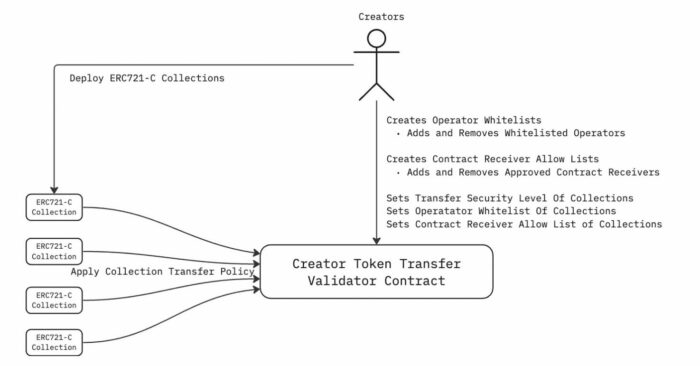What is ERC721-C and can it solve Web3’s royalty problems?
Creating royalties has become an important point of contention in the NFT space. This shouldn’t be news to anyone who claims Web3 is their pedal. But what should be surprising is that the debate surrounding the necessity of royalties has failed to make any truly significant progress since its inception.
Sure, most of the NFT space’s most prominent marketplaces have taken a stand on the matter. Yet, by and large, innovations like Manifold’s royalty registry have not secured creators their royalties. That does not mean that there are no developers who are actively trying to remedy the situation. It sure is, and the recently announced ERC721-C standard is undoubted evidence of such efforts.
What is ERC721-C?
ERC721-C is a new type of token standard created to effectively make on-chain royalties enforceable. Unlike ERC-721 and ERC1155 – the most created and traded type of NFTs – this new standard makes royalties programmable, allowing creators to block fee-free exchanges from platforming their works once and for all.
Developed by blockchain gaming company Limit Break, ERC721-C (and ERC1155-C) allows creators to set new rules for on-chain royalties. Simply put, this new standard means that artists and developers can create some sort of permissive smart contract that dictates where and how royalties are transferred.
Essentially, this new type of customizable royalty contract allows creators to choose where their NFTs are sold and allows them to filter interactions from just the contracts and applications they choose themselves. Traders will no longer be able to bypass royalties by using zero-fee platforms because any pool created with ERC721-C can simply opt out of trading on such marketplaces.
How can ERC721-C be used?
Limit Break’s new advent can also be applied to a number of other use cases beyond simple end-to-end royalty transactions. As noted by strategist and author Hunter Solaire in their tweets below, users of this new standard can easily find dynamic ways to adjust their royalties to benefit themselves and their supporters.
Now you can:
Give them royalties for the first 10 sales
Set royalty to 0% if the NFTs are trading below the coin price
Give them 1-100% of future royalties on the NFT they minted
Another one 👇
13/7 pic.twitter.com/want3MOSbY
— Hunter Solaire ᵍᵐ (@huntersolaire_) 15 May 2023
Not all holders are the same:
Some buy to flip or keep quiet
Others buy, make it their identity and fight for your brand every day
Now you can reward your most valuable community members or DAOs with a royalty % on NFTs with specific properties or rarities
9/13 pic.twitter.com/C1F5zBrFGd
— Hunter Solaire ᵍᵐ (@huntersolaire_) 15 May 2023
ERC721-C could potentially even be used for community-building initiatives, as royalties from sales could be automatically shared between, for example, members of a DAO or winners of a contest. But instead of kickbacks happening forever, creators can spread how many percentages are handed out, when and how often.
Also, ERC721-C is built to be fully backwards compatible, meaning it will work seamlessly with existing on-chain and marketplace standards. About this specific functionality, CEO of Limit Break, Gabriel Leydonexpressed his excitement below a Twitter space by saying, “You’ll actually be able to block exchanges for real now, and there’s nothing they can do about it.”
“The standard that everyone is using right now can’t defend royalties,” Leydon added. “This is the real deal. This is a real chain solution for royalties. This will work, it’s going to work, and in my opinion, it’s going to change the internet.”
When will ERC721-C be in action?
An important consideration to be made with ERC721-C and ERC1155-C (or other new standards like ERC-6551 or BRC-20, for that matter) is that they will not be adopted overnight. Although interest has spread evenly throughout the NFT space, the standard is new and relatively complex and could be further enhanced if more features are added.

Similarly, the customization features established by ERC721-C will likely mean that marketplaces will need to update their platforms to accommodate. But of course, even this step cannot be achieved until Web3 sees proof of the viability of the new standard in the form of a successful assembly implementing the new standard.
All in all, those who support royalties for creators should keep their attention on this new standard rather than the infighting that ensues between marketplaces. Because, as Leydon put it during Twitter Space, “It’s ultimately the creator that drives the volume, not the exchange.”


